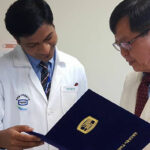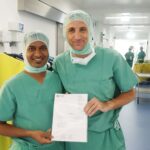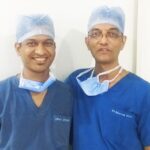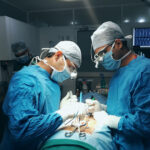KNOWLEDGE BASE
What is a spinal disc?
A spinal disc is the ligamentous structure that attaches one vertebra to the next adjacent vertebra. The purpose of the disc is to allow for motion of the spine. Many people consider the disc to be a “shock absorber” between the bones of the spine. This is just one purpose of the disc. Another important function of the disc is to allow for motion in the spine. The disc is a very tough ligament that allows the spine to move in multiple directions, i.e., flexion, extension, side-bending to the right or left, rotation to the right or left, and distraction and compression along the axis of the spine. A healthy disc has a soft central portion, which is often likened to a jelly-like center. The outer portion of the disc consists of very tough ligaments arranged circumferentially. It is made of multiple layers crisscrossing as they encompass the jelly-like center. This very tough outer ligamentous portion allows the spine to move in multiple directions. The disc itself lacks any specific blood supply or nerves within the disc. However, the outside of the disc is richly innervated with nerve fibers. These nerve fibers on the outside of the disc if stimulated or irritated can cause severe back pain
Why does an injured disc cause pain?
The nerves that supply pain sensation to the outside of the disc are different than the nerves that pass behind the disc and travel down into the extremities. Pain or irritation of the nerves that innervate the outside of the disc produce central back pain if the disc is located in the low back. If the disc is located in the neck, then neck pain is produced. Injury to the disc can cause pain in several ways. First, the injured disc can be painful just by tearing the outer portion of the disc and irritating the nerves that innervate the outer edge of the disc. This is called an annular tear. Secondly, the injured disc may begin to degenerate, causing enzymes to be produced. These enzymes can leak out of the disc and further irritate the nerves on the outside of the disc. This is a common cause of chronic back pain. Third, the injured disc is often weakened and does not function properly. Specifically, it does not prevent abnormal motion of one vertebra in relation to the next. For example, if a knee ligament or shoulder ligament were injured and stretched, the individual would lose support in that knee or shoulder. The same happens at a microscopic level in the back when a disc is injured. This allows for micro-translational movements of the disc causing irritation of the nerves that innervate the disc, as well as of the surrounding facet joints and supporting tissues. This micro-instability further accelerates the degenerative process and increases production of degenerative enzymes that aggravates back pain. This is the most common scenario present in chronic low back pain situations. An injured disc can also cause a piece of disc tissue to break off and compress surrounding nerves as they pass to the lower extremities. Pinching of these nerves usually causes leg pain if the pinch is in the low back or arm pain if it is in the neck; however, depending upon the position of compression, they may also cause central pain in the neck or in the low back.
What is the difference between a herniated disc and bulging disc?
A normal healthy disc has a usual height and shape. The center of the disc has high water content and acts as a tall shock absorber. As a disc begins to degenerate and lose its normal water content, it loses some of its ligamentous strength. With this loss of water content, there is usually a loss of disc height. When the disc becomes shorter it causes the edge of the disc to protrude beyond the edges of the bone. This is comparable to letting air out of a car tire. As a car tire loses air, the tire broadens out as it loses height. The same is true for a disc. When the disc extends beyond the normal edge of the bone by greater than 50% of the circumference, it is termed a bulging disc. A bulging disc may pinch a nerve, causing extremity pain. More often than not, a bulging disc is associated with back pain. A herniated disc occurs when a portion of the disc extends beyond the edge of the normal bony edges and measures less than 50% of the circumference of the disc. A disc herniation usually occurs when the outer lining of the disc becomes torn, allowing a portion of the disc material to express out of the normal confines of the disc itself. If this disc material extends out and pinches one of the nerves passing by as it goes to an extremity, it often produces radicular pain into that extremity. Specifically, if a part of the disc extends out of the disc in the low back and pinches one of the nerves to the leg, pain will extend down into the leg in a specific pattern to that nerve. This is called radiculopathy. If disc material that has herniated does not pinch or irritate a nerve going to an extremity, often there will be no leg symptoms. In fact, there may be no symptoms or just back pain.
What is a herniated disc?
A disc is the shock absorber between adjacent vertebrae. When it deteriorates it may “bulge”, “slip”, “rupture” or “herniate” and press on the spinal cord or nerve roots. Herniation means that a piece of disc is somewhere it does not belong.
Are bulging discs normal in an adult?
Bulging discs are extremely common. The incidence of significant disc changes on an MRI scan is almost identical to the age of the patient. For example, if one hundred 40-year old patients underwent MRIs of the cervical spine, approximately 40% of them would show some degenerative disc changes. While these changes are technically abnormal, they are extremely common and occur as a consequence of the normal aging process.
How did I herniate my disc?
Some disc herniations occur during injuries, such as motor vehicle accident, excessive lifting episodes or falls. In those instances, the mechanism of injury is obvious and pain will develop soon after the event. More often, patients develop a herniation without an obvious trauma. In those instances it is postulated that the herniation developed due to cumulative effects on the disc. A series of relatively minor injuries may have accumulated to the disc where the disc was weakened to the point of herniation.
What are the symptoms of a herniated disc?
A herniated disc is defined as a disc where the outer lining has been torn, and the inner soft disc material has expressed out of the tear. Often this compresses the adjacent nerve roots. This pressure on the nerve roots tends to cause low back pain and leg pain which can be accompanied by numbness and weakness. When disc herniations are very severe, they can even affect the function of the control of the bowel and bladder. This is called cauda equina syndrome and tends to be a very unusual complication of disc herniation. This is an emergency and needs immediate medical attention.
Are all bulging discs and/or herniated discs painful?
Many people have discs that are degenerative or abnormal and yet experience no symptoms. It is also possible that they may have had symptoms at one time, but symptoms improved without any specific intervention. Many times, these degenerative discs are not painful at all until some significant injury or trauma damages them further, leading to significant instability and pain. The bottom line is just because a disc is abnormal does not mean it has to be painful.
What are common causes of back pain?
Back pain is one of the most common ailments; approximately 80% of the adult population will develop a significant episode of back pain sometime during their life. Fortunately, most of these will spontaneously resolve. However, approximately 10% to 20% will develop into significant chronic and/or recurrent episodes of back pain. Wear and tear conditions, such as degenerative arthritis and degenerative disc disease, are some of the most common causes. Low back joint restrictions and/or sacroiliac joint restrictions are also a common cause of acute low back pain. Muscle pulls and tears may also cause low back pain, but usually the symptoms from muscular causes are short-lived. Weak muscles, poor flexibility, and poor posture all aggravate underlying conditions and worsen symptoms. Uncommon causes of pain include infection, cancer, fractures, aneurysms, and/or internal organ problems.
What is the natural history of low back pain?
The natural history of low back pain improves over a few days to one to two weeks. In fact, 90% of patients report that pain has subsided by two months without any intervention. However, 40% of patients develop significant recurrent symptoms within six months of the initial onset of symptoms. Fortunately, most recurrences are not disabling but may lead to chronic problems with intermittent episodes of exacerbation. Approximately 10% to 20% of patients who develop low back pain develop significant chronic low back pain which limits them.
When do most people develop significant low back pain?
The usual age of onset of severe low back pain is between 30 and 50 years of age. The most likely reason is that the degenerative process has begun, and individuals in that age range are still active enough to stress their bodies and place somewhat degenerative discs at risk for injury. It is also common in this age group for individuals to be very preoccupied with their life and occupation and in turn not take as good care of themselves as when they were younger. This leads to increased stress on the discs predisposing them to injury. The incidence of low back pain is equal between males and females. It is not uncommon for adolescents to experience low back pain. While this was previously thought to be a sign of severe potential problems, it is now recognized as common entity and usually not dangerous. Fortunately, it is often self-limiting as adolescents learn good body mechanics and participate in proper strengthening and conditioning for their spine and overall body.
How can I prevent back pain?
Prevention is the best strategy for coping with back pain and can save a great deal of time and agony.
Practicing proper body mechanics and improving your physical condition can help prevent back pain. Regimens that includes conditioning and strengthening exercises can help prevent and reduce back pain. Exercising your core muscles—those in your abdomen and back—strengthens them and can help prevent back pain.
How can I prevent back pain?
Prevention is the best strategy for coping with back pain and can save a great deal of time and agony.
Practicing proper body mechanics and improving your physical condition can help prevent back pain. Regimens that includes conditioning and strengthening exercises can help prevent and reduce back pain. Exercising your core muscles—those in your abdomen and back—strengthens them and can help prevent back pain.
Maintaining a healthy weight
Excess weight strongly contributes to back pain and almost all other conditions affecting the spine. If you are currently overweight, trimming down can help ease your back pain.
Maintaining proper posture
Keep your pelvis in a neutral position. If you need to stand for long periods, alternate placing a foot on a low stool to take some of the pressure off your lower back. When sitting, look for seats with good lower back support, arm rests and a swivel base. Consider placing a pillow or rolled towel in the small of your back to maintain its normal curve. Keep your knees and hips level.
How can I incorporate ergonomics into my everyday lifestyle?
Applying ergonomics can help prevent repetitive motion injuries such as carpal tunnel syndrome, particularly if you are constantly working at a computer.
Use a headset for lengthy or frequent telephone work.
A footrest should be used if, after adjusting the height of the chair, feet do not rest flat on the floor.
When performing daily tasks, alternate between sitting and standing or take small walking breaks throughout the day.
Position the monitor directly in front of the user to avoid excessive twisting of the neck.
When typing, press the keys gently; do not bang them or hold them down for long periods.
Keep your shoulders, arms, hands, and fingers relaxed.
Practicing safe lifting
When you lift large or heavy objects, keep your back straight and bend only your knees. Hold the load close to your body and avoid lifting and twisting at the same time.
Sleeping properly
Medium-firm to firm mattresses can help people with back pain. If you sleep on your side, try putting a pillow between your knees. If you sleep on your back, place a pillow under your knees. You can use a small rolled towel to support your lower back.
Is bed rest a good treatment for back pain?
Traditionally, bed rest was the recommended treatment for back pain. However, recent studies show that bed rest is counterproductive and often detrimental in treating back pain. Bed rest allows muscles to de-condition and significantly slows the rate of recovery from acute back pain. The recommended activity modification for patients with back pain is to stop whatever activity causes back pain. Specifically, if bending and lifting cause back pain, then avoid bending and lifting. If a twisting motion, such as playing golf, causes back pain then stop playing golf. However, persons with back pain should remain as active as possible as long as they are not having pain. Bed rest should only be used in cases where the patient is having severe pain and cannot even tolerate simple activities of daily living, such as standing, walking, or sitting without suffering severe pain. In these cases, a very short course of bed rest combined with appropriate medication is often found to be beneficial. Bed rest should be limited to the amount of time it takes to get pain under control then the patient should be placed into an aggressive rehabilitation program consisting of strengthening and joint mobilization.
Does smoking cause spine problems?
Yes. Smoking accelerates the degenerative process of disc degeneration. The spinal discs do not have a naturally abundant blood supply. Smoking causes blood vessels throughout the body to become smaller, reducing the amount of blood and thus oxygen and nutrients delivered to tissues. The discs are greatly affected since they already have a poor blood supply. Smoking has also been linked to increased perception of pain amongst people who undergo treatment. Because of increased pain, it is associated with increased use of narcotics in trying to control pain and increased dissatisfaction with non-operative and operative treatment of back problems and other orthopedic disorders. In patients who undergo surgery, the overall success rate is much lower in smokers when all other factors are equal. The bottom line is that we know that smoking causes heart disease, lung disease, vascular disease, and cancer. In addition, smoking is linked to increased perception of pain and spinal problems.
When should you consult your Spine Surgeon about back pain?
See your Spine Surgeon if you experience any of the following:
Numbness or tingling
Pain as the result of a fall or injury
Severe pain that doesn’t improve with medications and rest
Pain, weakness or numbness in your leg or arm
Urinary or bowel dysfunction
Any of these symptoms are signals of a serious problem requiring treatment.
Should i have an MRI for my pain?
The decision to have a MRI scan should be made by your Spine Surgeon after a careful history and physical examination. The vast majority of patients with arm/leg or neck/back pain will improve with time by themselves without having any sort of therapy or testing. Unless there is evidence of a significant neurological deficit, waiting for several weeks is desirable prior to obtaining a MRI scan. The MRI scan and associated findings can actually lead to significant confusion in terms of patient diagnosis when done immediately. If you are, however, suffering significant weakness, problems walking, or any trouble with your bladder, an MRI is essential.
When is surgery necessary for patients with spine problems?
More than 90% back problems respond to conservative treatments, including anti-inflammatory medication, hot or cold therapy and physical therapy.
When conservative treatments don’t alleviate the pain, other therapies may be used, including: epidural steroids, injections, joint and nerve blocks, and medications. If interventional therapy does not help, back surgery may be considered as a last resort.
Surgery may be appropriate for patients experiencing severe pain or when there is a significant neurological impairment, such as muscle weakness, a change in gait, or bowel and urinary dysfunction.
What are some nonsurgical treatments that relieve back pain?
Most neck or back pain improves over time with a combination of rest, pain relievers and hot or cold therapy. If pain does not improve, physical therapy, exercise, nonsteroidal anti-inflammatory drugs, muscle relaxants, cortisone injections or electrical stimulation can help.
Low doses of certain types of anti-\depressants also have been shown to relieve pain.
Will losing weight decrease the chance I will need back surgery?
While degenerative disc disease and spine disease has a large genetic component, there are actions you can take to prevent or decrease odds of developing back pain requiring surgery. In addition to putting extra strain on your neck and back, extra weight
What can i do to avoid neck surgery?
It is important to realize that neck and arm pain related to cervical disc disease is often a benign condition that will resolve with rest, medication, and sometimes physical therapy. If you are suffering from neck or arm pain related to cervical disc disease, it would be best to be evaluated by a spine specialist. Then, after other potentially more serious conditions have been ruled out, one can begin a program of neck rehabilitation. This consists of a workplace evaluation to maximize office ergonomics. Also, important sleep and rest habits have to be included. Lastly, alterations in work around the home or recreational activities can alleviate much of the problem.
Should I be scared of surgery and its complications?
No. Technological advances in spine surgery has made it less risky and with minimal complication. Complication rate in spine surgery has dramatically reduced after introduction of MISS technique.







